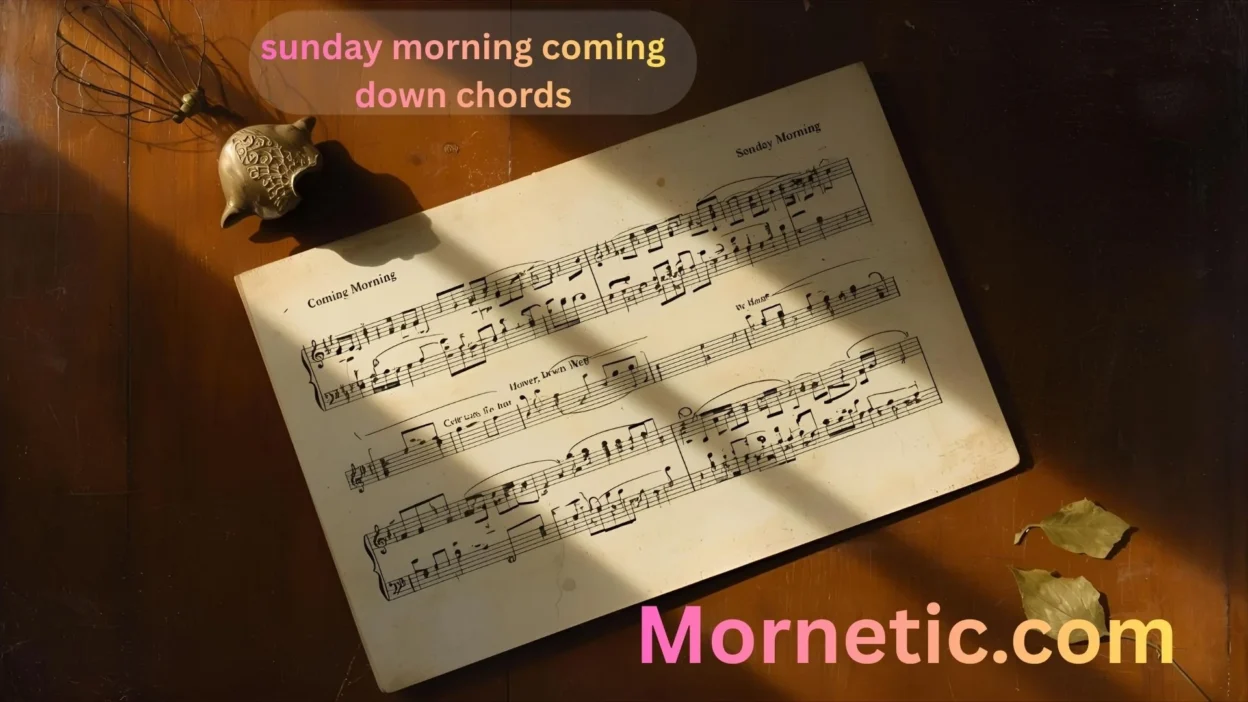There are few songs in the country music canon as hauntingly authentic as Kris Kristofferson’s “Sunday Morning Coming Down.” Its raw portrayal of loneliness and reflection resonates deeply, and for guitarists, learning the Sunday Morning Coming down chords is a rite of passage. This song isn’t just a series of chord changes; it’s a masterclass in storytelling through simple, powerful progressions. Whether you’re a beginner looking to strum along or an intermediate player aiming to capture the song’s soulful nuance, this guide will walk you through every step. We’ll break down the essential chords, the iconic “walking” bass line, and the subtle rhythmic touches that make this song a timeless classic, ensuring you can play it with confidence and feeling.
The Story Behind the Song: Kris Kristofferson’s Masterpiece
Before we dive into the fretboard, it’s crucial to understand the heart of the song. “Sunday Morning Coming Down” was penned by a young Kris Kristofferson, who was working as a janitor for Columbia Records while trying to make it as a songwriter. The lyrics are a semi-autobiographical account of a lonely Sunday after a long, hard week. The song’s genius lies in its vivid imagery and palpable mood, which perfectly complement the melancholic chord progression.
- The Writer’s Struggle: 🎤 Kristofferson wrote this from a place of genuine experience, capturing the feeling of isolation and longing for connection.
- Johnny Cash’s Landmark Cover: 📺 While Kristofferson recorded it first, it was Johnny Cash’s 1970 live performance on his TV show that catapulted the song to fame, winning a CMA Song of the Year award.
- A Songwriter’s Blueprint: ✍️ It remains a gold standard for aspiring songwriters, demonstrating how personal, specific stories can achieve universal appeal.
Essential Chords You’ll Need to Play
The good news is that the chord structure for “Sunday Morning Coming Down” is relatively simple and uses common open chords. If you’ve been playing folk or country music for any length of time, you likely already know them. The magic is in how they are arranged and performed.
- C Major (C): The foundational chord of the verse.
- G Major (G): Used throughout the verse and chorus.
- A Minor (Am): Adds a touch of melancholy.
- F Major (F): Provides a warm, resolving sound. (The open F chord with the thumb-over technique is commonly used).
- D Minor (Dm): A key chord that deepens the somber mood.
- E Minor (Em): Often used in transitions.
Tuning Your Guitar for Authentic Sound
Getting the tuning right is the first and most critical step. “Sunday Morning Coming Down” is traditionally played in a specific tuning that gives it its distinctive, resonant sound.
- Standard Tuning? While some play it in standard, the classic sound comes from Drop D Tuning or Open G.
- Recommended Tuning: Standard Tuning (E-A-D-G-B-e) is perfectly fine for learning the basic progression. For the authentic Cash/Kristofferson vibe, tune to Drop D (D-A-D-G-B-e). This lower tuning adds a deep, droney quality that fits the song’s mood perfectly.
- Pro Tip: 🎸 Use a digital tuner and double-check your low E string is down to D. Strum the open D and A strings together to hear the powerful, resonant fifth interval.
The Core Chord Progression: Verse and Chorus Breakdown
Let’s get to the heart of the matter. The entire song is built on a repeating, cyclical chord progression. We’ll start with the verse, which establishes the song’s signature lonesome feel.
Mastering the Verse Progression
The verse follows a predictable and beautiful pattern. In the key of C, the progression is primarily: C – F – C – G. However, Kristofferson adds a crucial passing chord that makes all the difference.
- The Basic Pattern: Strum | C | F | C | G |
- The Kristofferson Touch: The actual progression introduces a Dm and an Am for emotional depth. A more accurate representation is: | C – – – | F – – – | C – – – | G – Dm – G – |
- Walking Bass Line Preview: Notice the movement from G to Dm and back to G. This is a precursor to the walking bass line we’ll explore later.
Navigating the Chorus Changes
The chorus provides a lift and a sense of release from the contemplative verse. The chords change a little faster here, driving the melody forward.
- The Chorus Progression: The chorus typically uses: | C – – – | F – – – | C – – – | Am – G – |
- The Emotional Shift: 🎶 The shift from C to F feels like a question, while the resolution from Am to G feels like a bittersweet answer, perfectly mirroring the lyrics about wishing for a different reality.
Strumming Patterns: Finding the Right Feel
You can play the correct chords, but without the right strumming pattern, it won’t sound like “Sunday Morning Coming Down.” The feel is a relaxed, “boom-chuck” country pattern.
- The Basic “Boom-Chuck”: This pattern emphasizes the bass note on beat 1 and a strum on beats 2 & 3. In 4/4 time, it’s: Bass – Down – Down – Up
- Applying the Pattern: For a C chord, you would pick the bass note (5th string) and then strum down on the rest of the strings, and so on.
- Adding Swagger: 🤠 Don’t be too rigid. The best players slightly drag the tempo, letting the rhythm breathe. Listen to Cash’s version for the ultimate example of this laid-back swagger.
The Iconic Walking Bass Line Technique
This is what separates a basic strum from a professional-sounding performance. A walking bass line connects the chords by moving stepwise between the root notes. It’s simpler than it sounds and incredibly effective.
- What is a Walking Bass? It’s a bass note progression that “walks” from one chord to the next using the notes of the scale.
- Example in the Verse: In the C to F change, instead of just jumping from a C bass note to an F bass note, you can walk up: C (root) -> D (2nd) -> E (3rd) -> F (root of new chord).
- How to Play It: Use your thumb to pluck these individual bass notes on the lower strings while lightly brushing your fingers across the higher strings for rhythm.
Capo Placement and Key Variations
What if you want to sing along but the key of C is too low or too high for your voice? A capo is your best friend.
- Original Key: The song is famously played in C (often with a capo to match the recording’s pitch).
- Using a Capo: If you place a capo on the 3rd fret and play the C-shaped chords, you are actually playing in the key of Eb. This is a very common setup for this song.
- Finding Your Key: 🎤 Experiment with the capo on different frets. If C is too low, try the capo on the 2nd fret (key of D) or 5th fret (key of F). The chord shapes remain the same!
Step-by-Step Tutorial for Beginners
Let’s put it all together in a simple, actionable plan. Don’t get overwhelmed; focus on one step at a time.
- Step 1: Learn the Chords Individually. Practice moving smoothly between C, F, G, and Dm without any rhythm.
- Step 2: Master the Progression. Play the verse progression (C – F – C – G – Dm – G) over and over until your fingers find the shapes without looking.
- Step 3: Add a Simple Strum. Use a basic down-up strumming pattern to get the chords ringing out in time.
- Step 4: Introduce the “Boom-Chuck.” Once comfortable, try the bass-strum pattern on a single chord before applying it to the whole progression.
Advanced Techniques for Intermediate Players
Ready to take it to the next level? Here’s how to inject more artistry into your performance.
- Hybrid Picking: Use a pick for the bass notes and your middle/ring fingers to pluck the higher strings. This creates a clearer, more articulate sound.
- Dynamic Control: Play the verses softly and introspectively, then build volume and intensity into the chorus. This tells a story with your dynamics.
- Hammer-Ons and Pull-Offs: Add subtle hammer-ons and pull-offs within your chords, especially on the G and C shapes, to create a more fluid, vocal-like melody.
Common Mistakes and How to Fix Them
Even experienced players can stumble on the nuances of this song. Here are the pitfalls to avoid.
- Mistake 1: Rushing the Tempo. The song should feel slow and weary. Use a metronome set to a slow speed (around 70-80 BPM) to internalize the laid-back groove.
- Mistake 2: Muddling the F Chord. The F chord can sound muffled if not fretted cleanly. Press firmly with your index finger for the barre and ensure each string rings out.
- Mistake 3: Ignoring the Lyrics. 🗣️ Your playing should serve the story. Phrase your strumming and pauses to accentuate the lyrics’ emotional weight.
Famous Recordings to Study for Inspiration
The best way to learn is to listen. Each artist brings a unique interpretation to the song.
- Kris Kristofferson (The Original): Study his raw, slightly ragged vocal and straightforward guitar work. It’s the purest form of the song.
- Johnny Cash (The Definitive Cover): Cash’s deep, authoritative voice and the iconic walking bass line from his TV special are the versions most people remember.
- Willie Nelson (A Friend’s Interpretation): Nelson’s nuanced phrasing and unique guitar timing offer a masterclass in feel and pocket.
Lyrics and Chord Integration
To truly master the song, you need to know where the chords change in relation to the words. Here’s the first verse and chorus with the chords placed correctly.
- (C) Well, I woke up Sunday (F) morning (C) with no way to (G) hold my (Dm) head that (G) didn’t (C) hurt.
- (C) And the beer I had for (F) breakfast wasn’t (C) bad, so I had (G) one more for (Dm) des-(G)sert.
- (C) Then I fumbled through (F) my closet for my (C) cleanest dirty (G) shirt (Dm)…
- (Am) Then I washed my face and (G) combed my hair and (C) stumbled down the (G) stairs to (C) meet the day.
Practice Routine for Mastery
Consistency is key. Here is a 15-minute daily routine to build muscle memory.
- Minutes 1-5: Chromatic warm-up exercises and chord transition drills (C to F, C to G, G to Dm).
- Minutes 5-10: Play through the entire song slowly with a metronome, focusing on clean chord changes.
- Minutes 10-15: Work on one specific advanced technique, like the walking bass line on just the C-to-F transition, or practice singing while playing a simplified strum pattern.
FAQ: Sunday Morning Coming Down Chords
What is the hardest part of learning “Sunday Morning Coming Down” on guitar?
For most players, the initial challenge is the F major barre chord. However, the true test is mastering the relaxed, behind-the-beat strumming pattern and integrating the walking bass line without losing the rhythm.
Can I play this song without a capo?
Absolutely. The song sounds perfectly fine in its original key of C without a capo. A capo is primarily used to change the key to better suit a singer’s vocal range or to match the pitch of a specific recording.
What key is “Sunday Morning Coming Down” in?
The song is written in the key of C Major. When played with a capo, the concert key changes. For example, with a capo on the 3rd fret, you are playing in the key of Eb.
Is this a good song for a beginner to learn?
Yes, but with a graded approach. A beginner can start by learning the basic C, F, and G chords with a simple strum. The walking bass line and more nuanced techniques are excellent goals for an intermediate player to work towards.
Who wrote “Sunday Morning Coming Down”?
The song was written solely by the legendary American songwriter Kris Kristofferson.

Grace is a lifestyle writer from California who loves starting mornings with positivity. At Mornetic, she shares uplifting quotes and cheerful messages to brighten your day.




